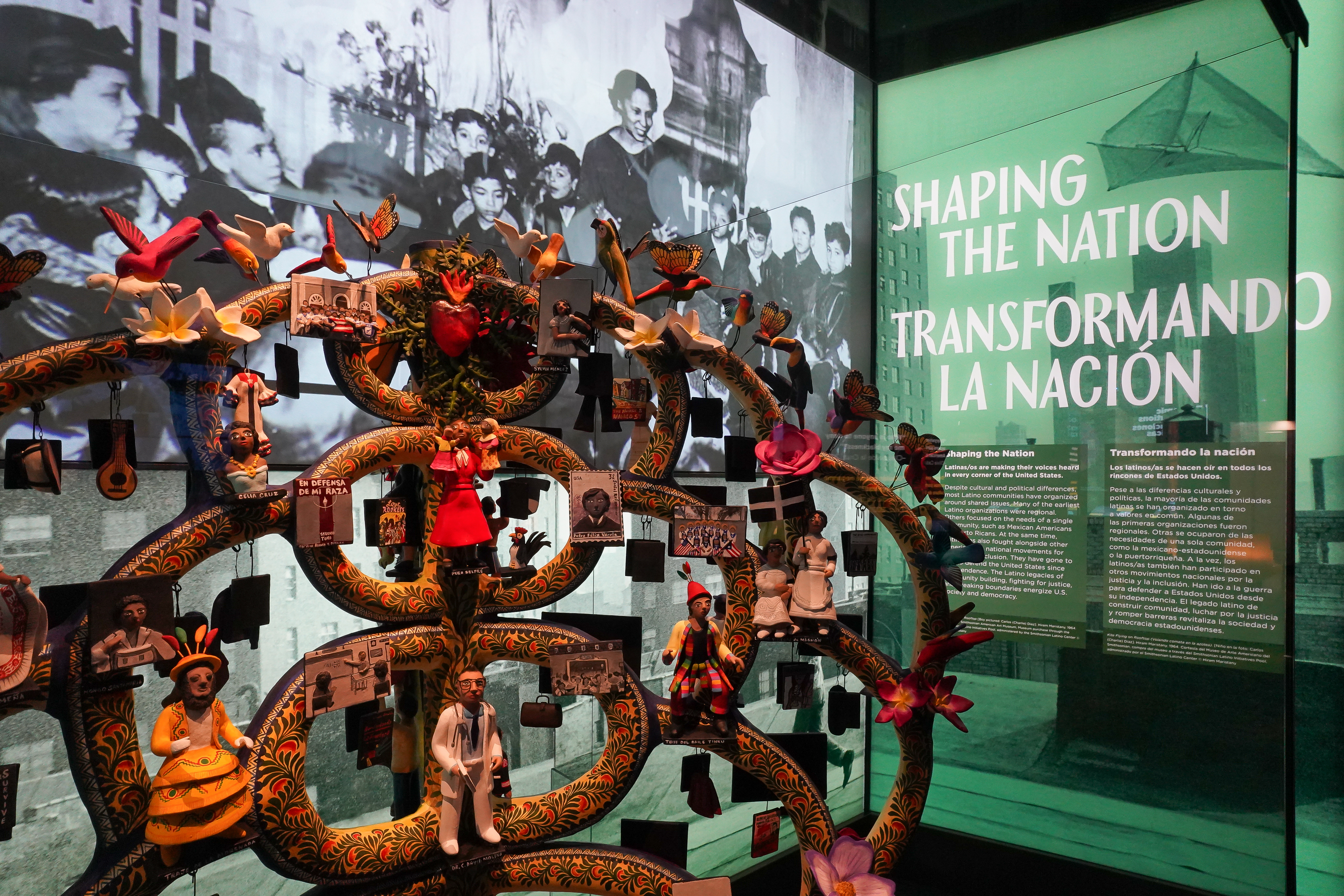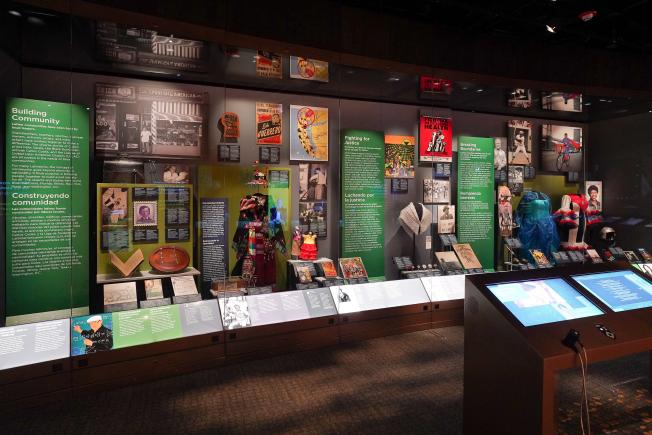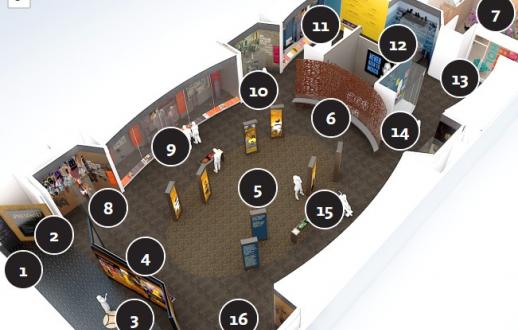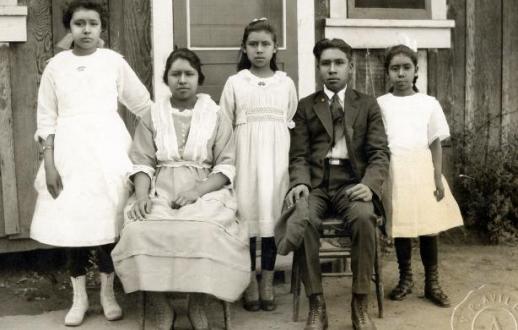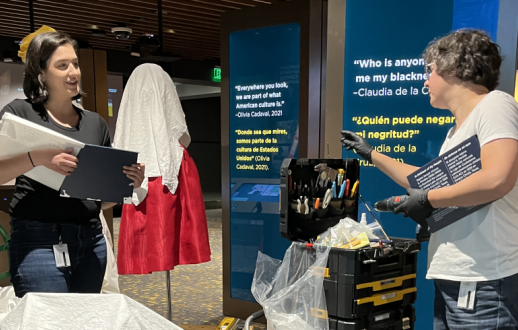(tranquil music)
Jorge: Lulu, welcome to the Molina Family Latino Gallery.
Lulu: I am so glad to be here. This is an extraordinary space. Tell me what I'm seeing.
Jorge: Well, this is the entrance to the Molina Family Latino Gallery, the first gallery of the National Museum of American Latino.
And you're greeted here by different representations, locations, neighborhoods and people that welcome you to the space
and tell you a little bit about themselves and then help you enter the space into our first exhibition, "Presente!"
Lulu: What are some of the shared experiences that this gallery is meant to show us about Latinos' complicated history in this country?
Jorge: Well, as part of the Smithsonian's larger initiative, Our Shared Future: Reckoning with Our Racial Past, we tackle some of those injustices and racism and colonialism but you also feature resiliency and resistance.
Lulu: I can't wait to see it. Let's go.
(lively music)
Jorge: This is a forum of Public Space Plaza where visitors can engage with each other, but also engage with these first person narratives that we have and actually learn more from other people and personalities that are featured in this exhibition.
Lulu: I'm standing here in this space and what occurs to me is that the story of Latinos in this country is this story of individuals.
Jorge: That is one of the key themes here. See yourself represented in these stories and in this exhibition.
(lively music)
Lulu: One of the things I always tell people when I talk about Latinos' history in this country is that we were here well before this country was even a country. And I can see here that that history is represented. Can you tell me a bit about what is in this part of the exhibition?
Jorge: Well, Latino history is American history. And to tell that full story and so a full history, we need to acknowledge our colonial past. So here we feature a portrait of Po'pay, the sculpture. He's a Tewa, leader, organized the Pueblo Revolt 1680.
We feature Toypurina, which is a medicine woman that was a post-colonial rule. So these are important stories to feature and highlight how important they are in shaping our future.
And these communities were around for hundreds of years before European colonization. So that's important on how that led to shaping our history.
Lulu: I'm also noticing, though, that it's not just our indigenous heritage that's being highlighted here but also our Afro-Latino heritage.
Jorge: Well, we have Francisco Menendez, which fled enslavement in South Carolina and led a militia in Fort Mose in Florida, a perfect example of resilience and resistance. And that's the theme that carries out through the exhibition, have that resistance, resiliency.
Those are very important to us.
(lively music)
Jorge: Lulu, in "Presente!" we further explore how racism and colorism developed during the colonial period. And we have a few examples in Puerto Rico that illustrate this point for visitors.
This 1973 poster by Augusto Marin emphasizes that role Black Puerto Ricans in the abolition of slavery on their island 1873. We can also find deep historical meaning in Latino music and dance traditions.
This outfit belonged to Tata Cepeda, an icon of Puerto Rican Bomba music. Bomba's a family of rhythms and dances with African and Caribbean roots that historically offered Black Puerto Ricans a space for creative resistance and renewal. Bringing it back to today, here's a great photo by Joaquin Medina documenting the Black Lives Matter movement in Puerto Rico.
For us at the museum, Latino is a label that brings together racially and regionally diverse communities. Representing both our commonalities and our differences is a core part of our work.
(lively music)
Lulu: This is an extraordinary piece. I've seen things similar to this in Mexico but nothing quite like it.
Jorge: It's a beautiful piece by Veronica Castillo and it's a Tree of Life, story of creation. But this one shows a flora and fauna surrounding it from 32 different countries represented in this exhibit.
And then you have all different people that share their stories in this exhibit. You have Roberto Clemente, a famous baseball player, of course. Carmen Lujan, which is a softball player.
Many people don't know but she was very important in the Latino sports world. But then you also Celia Cruz, Sonia Sotomayor, other personalities that helped shape the nation.
(lively music)
Lulu: This is incredibly moving. You're Cuban American. I'm Cuban American. And this speaks to our shared history.
Jorge: This is a powerful object. This is a rafter right from Cuba with two men on it, made of styrofoam, cloth, couple pieces of wood for oars. And it speaks to the immigration experience and that there is no single immigration experience.
Here you see a story about struggle, leaving your country and the push and pull factors, what leads an immigrant to do that, to go through this incredible journey across the straits. But it's really a powerful image and it really speaks to the Latino community.
Lulu: Yeah, one of the things, as someone who's covered immigration a lot, and as an immigrant myself, when I look at this, I think about the hope and the dreams that people carry
in their hearts when they come here, but also how hard it is and the sacrifice that also comes with that journey.
Jorge: And those are the stories that we explore in this gallery. You know, what it means to be an immigrant, what it means to arrive in this country.
Now, if you were here in the past before Europeans arrived or if you arrived here yesterday, we have some so many common struggles and so many dreams that we want to achieve here in this country.
Lulu: I understand now that we've seen some of the gallery that this is just a seed that is going to grow.
Jorge: This exhibit is just one of first of many that we will have over the next 10 years to really expand and explore different themes and topics we wanna bring forward and see how people react to them and see how people engage with these exhibitions
as we build the National Museum of American Latino. But we're excited to continue to showcase different exhibitions and invite visitors to explore our racial past, present and future.
(lively music)
